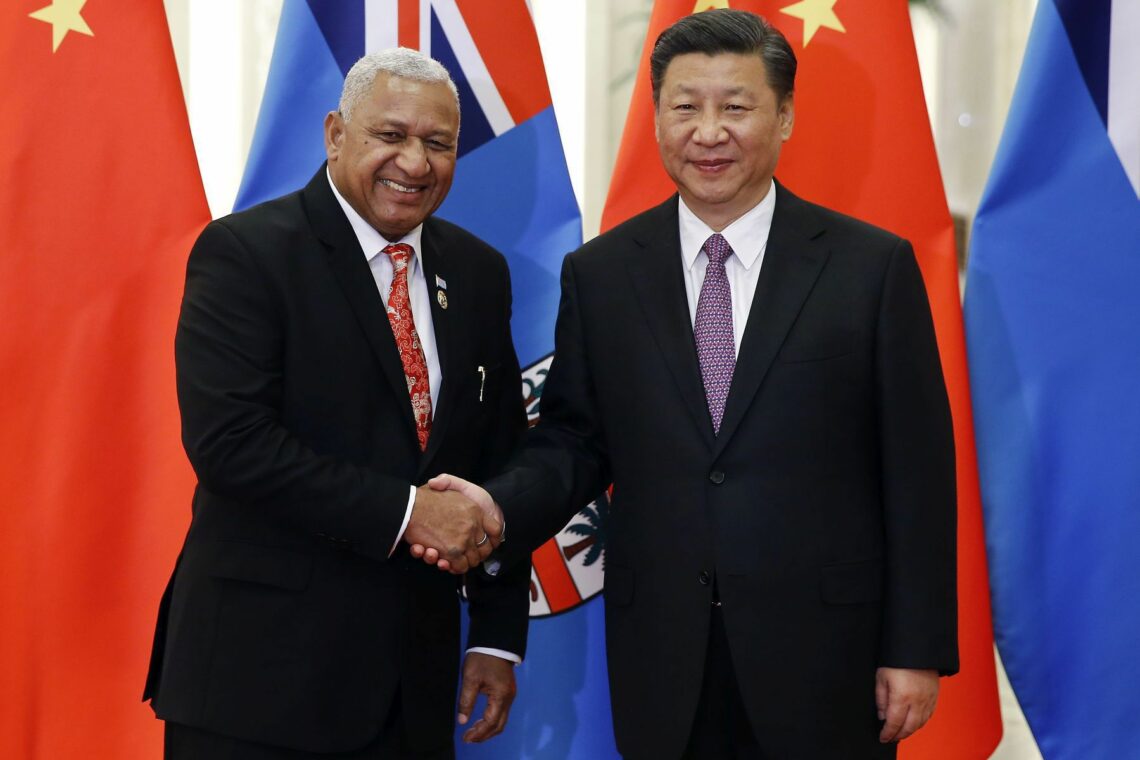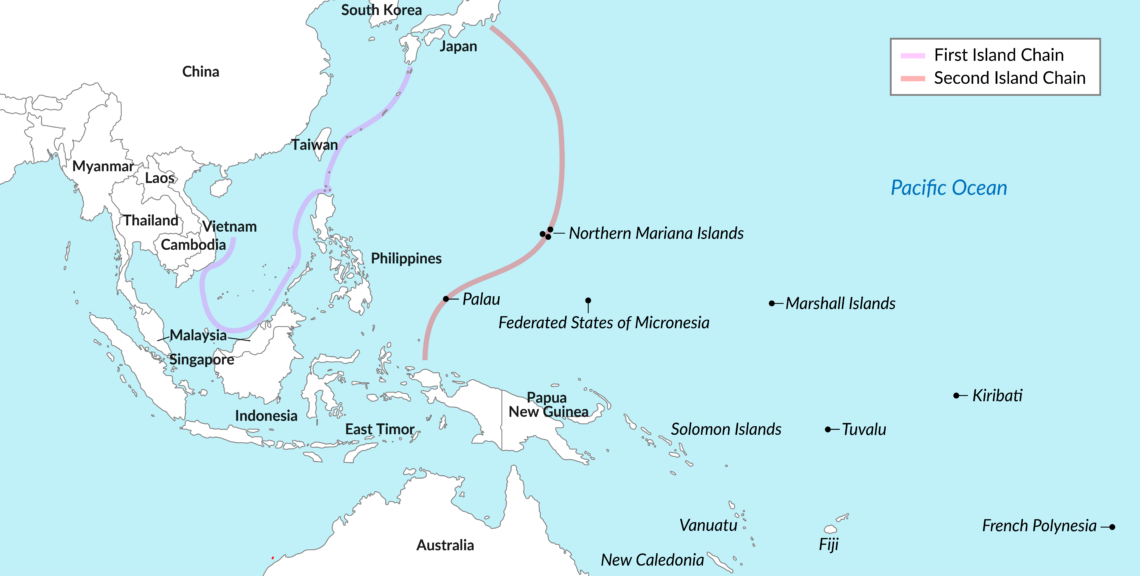The U.S.-China competition in the Pacific Islands
Small Pacific Island nations play a key role in Western military and diplomatic strategy. They host crucial bases and help provide international clout to allies like Taiwan. As China bolsters its influence in the pacific, Washington must decide how to respond.

In a nutshell
- The Pacific Islands have enormous strategic importance
- China is ramping up its economic and diplomatic activity there
- The U.S. has renewed its focus on the region
The United States has been a crucial player in the Southwest Pacific since the turn of the 20th century, and especially since the end of World War II, when it found itself in possession of several new territories there. As in other areas of the Indo-Pacific, China is challenging the U.S. position across this vast area. Washington’s response will play a key role in shaping the region.
Current political geography
The most striking aspect of the Pacific Islands is the distances involved. It is about 10,000 kilometers from the northernmost point in the Northern Mariana Islands to the southeastern end of French Polynesia – more than twice the distance from Lisbon to Moscow. From the east coast of Australia to Hawaii it is about 7,500 km. Scattered across this expanse are 14 small, dispersed, independent island nations. The largest among them are Papua New Guinea (by far the biggest), Fiji, Solomon Islands and Vanuatu.
Several major powers are resident in the region. The U.S. has three permanently inhabited territories there: the Commonwealth of the Northern Mariana Islands (CNMI), Guam and American Samoa. Washington also has special agreements with the Marshall Islands, the Federated States of Micronesia and Palau (known as the Freely Associated States) that grant the U.S. exclusive control over security matters. In addition, the U.S. exercises sovereignty over several uninhabited territories there.
Many of these islands mark important strategic transit points.
The other two important players in the region are France and Australia. France’s principal presence is in the semiautonomous New Caledonia and French Polynesia, which together are home to more than half a million people. French Polynesia covers an enormous area, making France one of the two biggest maritime nations in the world. Australia’s population of 23 million borders the region. It has close donor relationships with several states there, most prominently Papua New Guinea, over which it exercised sovereignty until 1975.
Many of these islands mark important strategic transit points. At the northern end of the region, where the U.S. is most present, in Guam and CNMI, they form part of the “second island chain” – a line of territory east of China that if controlled by forces opposed to Beijing’s regional and global ambitions, serve to box it in. In the south, Fiji, Solomon Islands, Tuvalu and Vanuatu sit between Australia and its security guarantor, the U.S.
Facts & figures

China’s growing activity
Now, China has entered the scene. Several developments have driven the concerns of the U.S. over the past four to five years:
- China has emerged as the region’s number-one trading partner and, by some measures, its largest foreign aid donor
- A Chinese company approached Tuvalu, offering to build islands to help the country deal with climate change. The offer was rejected
- There is a blossoming relationship between Fiji, under Prime Minister Frank Bainimarama, and Beijing, largely due to Chinese support of Mr. Bainimarama in the face of Western opposition to the 2006 coup that put him in power
- Two countries in the region, Kiribati and Solomon Islands, switched diplomatic relations from Taiwan to China after financial inducements from Beijing. Since Kiribati’s switch, there has been speculation that China plans to reactivate a satellite-tracking station it built on the island in the 1990s
- There are reports of Chinese interest in building a military base on Vanuatu, where the Export-Import Bank of China has already financed the construction of a commercial wharf on its very deep port. Vanuatu is about 2,000 km from Australia, and only 600 km from France’s New Caledonia
- A government-connected Chinese company tried to lease an entire island in the Solomons that had once served as a location for a World War II-era American military base
- China has deployed deep-sea submersibles and acoustic sensors in the Mariana Trench, off the coast of Guam
- Beijing apparently imposed a tourism ban on Palau, an extremely small economy heavily dependent on foreign visitors, presumably to pressure it to drop recognition of Taiwan
- According to research by Australia National University scholar Dr. Denghua Zhang, the People’s Liberation Army (PLA) of China has averaged about two delegations a year to the South Pacific, often accompanied by PLA ships
- Chinese investment and tourism in the American territory of CNMI, where the U.S. military trains, have increased significantly
Chinese strategy
Since Xi Jinping assumed office as general secretary of the Chinese Communist Party, Beijing has placed new emphasis on engagement in the Pacific Islands. There are two likely aims: pressuring Taiwan toward unification and stepping up its rivalry with the U.S.
Even after Solomon Islands and Kiribati switched their recognition to China, four of the 15 nations in the world that still recognize Taiwan are in the South Pacific. These “diplomatic allies,” as Taiwan calls them, help lend it legitimacy as a self-governing, sovereign nation. They serve as staging areas for official Taiwan travel where its leaders, including its president, are free to conduct government business. Taiwan representatives can travel there to participate in meetings of the region’s main multilateral gathering, the Pacific Islands Forum (PIF), while its assistance helps position Taiwan as a responsible global stakeholder.
China’s activity is part of a broader pattern designed to ease the U.S. out of its predominant position in the broader Indo-Pacific region. As the Chinese occupy strategic points or exercise influence on island nations in the southern part of the region – between Australia and the U.S. – Canberra could lose confidence in Washington’s security guarantees. Weakening the American hold along key points of the second island chain in the north, in places like the CNMI and Palau, helps China consolidate power closer to home and project power beyond.
These aims go hand in hand with Beijing’s Taiwan strategy, because as long as a country like Palau recognizes Taiwan instead of China, Chinese influence there is limited. Moreover, breaking the second island chain would complicate any attempt by the U.S. to fall back to its territories and allies there, an idea long suggested by American strategists in the face of growing Chinese military capability. This would weaken the force of American security commitments to Taiwan. It would have the same effect on commitments to Japan, South Korea and the Philippines.
U.S. reaction
After a prolonged period of neglect, the administration of President Barack Obama renewed U.S. attention toward the South Pacific. To demonstrate this new commitment, in 2012, Secretary of State Hillary Clinton (accompanied by the head of the U.S. Pacific Command) became the first American in her position to attend the PIF. A year later, Secretary of the Interior Sally Jewell (head of the department responsible for overseas American territories) became the first in her position to attend the meeting.
The U.S. continues to provide major financial support to the region
The Trump administration has continued and intensified this focus. Its commitment was best symbolized by a 2019 meeting at the White House, the first among the U.S. president and the presidents of the Freely Associated States. President Donald Trump has also sent to the region four cabinet secretaries, including the secretary of state, and for the first time, the defense secretary.
More substantially, the U.S. continues to provide major financial support to the region. The funding mostly goes to its territories and the Freely Associated States, where U.S. government spending constitutes especially large shares of the local economies. In Guam, for instance, such spending accounts for more than a third of the territory’s gross domestic product (GDP). Guam hosts two American military bases.
Although conveyed through different mechanisms, this percentage is similar in the much smaller economies of the Marshall Islands and Micronesia. The Trump administration also continues to supply the broader region with traditional aid programs, amounts it supplemented this year to respond to the Covid-19 crisis.
The question is how this approach will evolve in light of China’s burgeoning interest in the region.
Scenarios
Scenario 1
The most likely scenario is that the U.S. will continue to intensify its commitment to the region. In this scenario, U.S. territories in the second island chain become increasingly important as U.S. assets inside the first island chain – in the South China Sea and Japan, for example – become more vulnerable to the Chinese military. In fact, due to the U.S. military restructuring its presence in Japan, its footprint in Guam is already growing. One could also expect the American military’s use of land in the CNMI to increase. The U.S. will not allow rising Chinese economic involvement in the CNMI to compromise its interests in the region.
The compacts that the U.S. has with the Freely Associated States expire in 2023 and 2024. In this scenario, the U.S. recognizes them for the bargain they are in an era of great power competition and renews them on terms largely welcomed by local populations.
Meanwhile, it continues its stepped-up engagement of independent South Pacific nations through diplomatic involvement in regional forums like the PIF. It coordinates approaches with other powers in the region, especially Australia and France – as it does currently in the Quadrilateral Defense Coordination Group and in a joint project with Australia to expand a naval base in Papua New Guinea.
In this scenario, the U.S. recognizes the strategic importance of Taiwan in the region. The U.S. has not been promoting Taiwan there only because it wants the island nation to maintain its diplomatic and economic autonomy. The U.S. can never allow Taiwan to be absorbed by China, particularly a China led by the Communist Party. But Washington also realizes that official relations with Taipei are a barrier to close relations with Beijing. Taiwan is also a meaningful contributor of assistance in areas like disaster response and pandemic management.
Energy in the U.S. approach will help galvanize allies and partners in the region. Chinese efforts to find new bases for its military will be thwarted. Its investments will either flow into innocuous areas with little impact on its influence or dry up in favor of other priorities elsewhere. The Chinese will remain engaged, but they will content themselves with diplomatic visits and port calls, waiting for a slackening of American interest. The U.S., in the meantime, will retain its decades-long stabilizing security role in the broader Indo-Pacific.
Scenario 2
This scenario is less likely. It begins with a penny-wise and pound-foolish mindset in Washington or an even more improbable political consensus around a broad withdrawal from America’s global commitments. The U.S. government’s post-Covid crisis debt levels remain a source of uncertainty. Military spending becomes a prime target for budget cutters.
In this scenario, Washington proves unable to prioritize, and so instead of concentrating defense resources in the Indo-Pacific, it seeks to distribute budget cuts among its global commitments. This constrains the ongoing construction of military facilities in Guam and limits the use that other territories and island partners can provide.
Further, Washington looks for minor savings by either not renewing its compacts with the Freely Associated States or by reducing the amount of funding involved. It also looks for savings in the minor amounts provided to the independent island countries, to cobble together larger amounts for bigger priorities outside the Indo-Pacific.
With little to offer and preoccupied with domestic concerns, U.S. diplomatic engagement becomes a mere formality, lacking any high-level political commitment. These moves open the path for China to gain influence in the region and marginalize the U.S. both in the Pacific Islands and among its allies like Australia and Japan.








